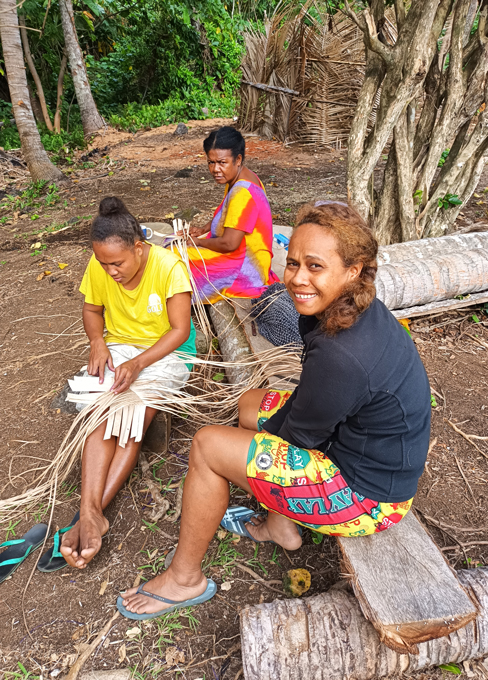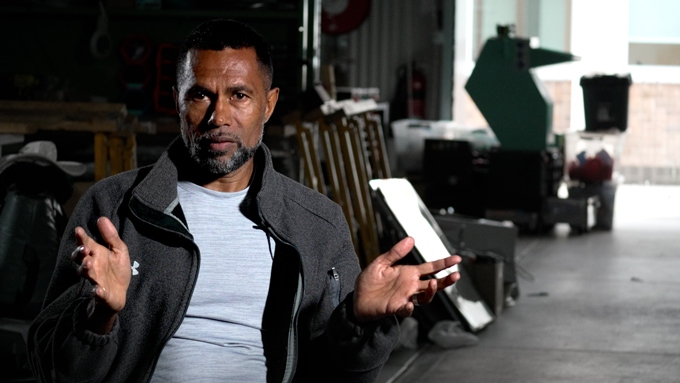When David Nalo proposed a disaster safehouse drawing from both Western technology and Ni-Vanuatu traditional engineering techniques, he found willing partners at the Bandalang Studio, the new Indigenous engineering hub at Australian National University (ANU).
Vanuatu is more at risk for natural disasters than any nation in the world. There are nine active volcanoes among its 83 islands. It suffers 20 to 30 cyclones per decade in addition to earthquakes, tsunamis, volcanic ashfall and eruptions.
The design for the safehouse will draw from the time-honoured knowledge of Vanuatu master builders, while ANU experts will contribute satellite communications and renewable energy expertise.
“Before, during and after natural disasters, communications can save lives,” said Mr Nalo, a 2023 Bandalang Resident.
Deadly lessons in the wake of Cyclone Pam
When Cyclone Pam hit Vanuatu in 2015 with winds of 250 km/hr, thousands of homes were destroyed, including many concrete buildings with iron roofing, with tragic results.
In remote areas, most people sought refuge in traditional structures. These buildings withstood the historic cyclone and those who sheltered in them survived.

“Our people have developed building techniques that have helped them stay safe in times of disaster,” Mr Nalo said. “The thatching of Natangura Sago palm fronds and wild cane is impermeable to water, but can open up to let the wind through.”
Roof and wall structures are made of bamboo, which is as strong as timber with the advantage of being lighter in weight. In some areas, a certain type of palm is used for posts that are naturally designed to anchor structures to the ground.
Instead of nails, the structures are fastened by vine cordage, treated with water to increase durability. The lashing creates a solid structure, but “retains some flexibility which is better for high winds”, Mr Nalo explained.
Flexibility also makes the structures more resistant to earthquakes, while steeply slanted roofs prevent the accumulation of volcanic ash.
Mr Nalo points out none of these innovations were taken into account as western-style buildings popped up, without proper building codes, throughout Vanuatu.
“We need to look back on what we can do for ourselves, using our own knowledge, recognising the good and the bad in external knowledge, and being able to make our own decisions,” he said.
Volatile environment creates engineering challenge
The traditional safehouse will be built on the island of Gaua.
“Gaua is in the Banks group of islands. They are usually the first to get hit by cyclones and the last to get relief because they are isolated with small populations,” Mr Nalo said.

Less populated islands can be without communications for months at a time. When cyclones develop, monitoring is difficult. High winds then knock down cellular towers, complicating relief efforts.
Mr Nalo’s plan is to have a satellite communication dish at the safehouse to allow consistent communications throughout disasters.
However, satellite installations require electricity and more than 70 per cent of Vanuatu’s people live beyond the reach of electricity grids.
Solar energy would require battery storage to supply electricity when cloudy skies or volcanic ash obscure the sun. Wind resources are abundant but gusts of 90 km/hr or more can damage turbines.
With Vanuatu’s largest waterfall just 3 km from the proposed site, the Bandalang Studio design team is exploring hydro-electricity in its renewable energy plan.
Pillars of resilience and cultural resurgence
Mr Nalo hopes this project will become a model that spreads throughout Vanuatu. His goal is to help his community restore self-reliance and provide a space to share cultural practices.
“Prior to colonisation, if a cyclone hit one island, that island
already had in place trade routes and systems of barter. So if one
island was badly hit, it could use those networks to get what it
needed from other islands that weren’t hit. It was very effective.”\
In recent decades, the Vanuatu government has struggled to provide
adequate disaster relief as the severity of cyclones has worsened due
to climate change.

Mr Nalo feels his country has become overly dependent on other nations for food supply, an important part of disaster relief.
“The tendency nowadays in Vanuatu, as in a lot of Pacific Island countries, is to look toward canned, processed food, whereas we have organic foods with complex carbohydrates right there growing out of the ground.” Mr Nalo said.
The gradual shift to imported, processed foods has led to climbing rates of diabetes, cardiovascular, and respiratory disease in Vanuatu.
“In normal times, when we are not facing a disaster, we will be using the safehouse to work on food preservation,” Mr Nalo said.
“We have different methods of food preservation that we have used in the past such as drying, smoking, fermenting, using fire, also burying under the ground. We will research these methods and encourage their revival for both public health and disaster resilience.”
ANU experts contributing to the project include fellow Bandalang Resident Dr Cat Kutay, Dr Jeremy Smith of the School of Engineering, Dr Chris Ballard, Ms Anna Cain, Mr Andrew Meares of the School of Cybernetics, Dr Wendy Christie of Monash University, and Mr Brad Riley of the ANU Centre for Aboriginal Economic Policy Research.
More about the Bandalang Studio:
- Bandalang Studio advocates for Indigenous systems design
- What is Indigenous Engineering Design?
- Ancient knowledge is reshaping new technologies
If you would like to see more of this kind of work, please consider supporting us through the School of Engineering General Fund.

